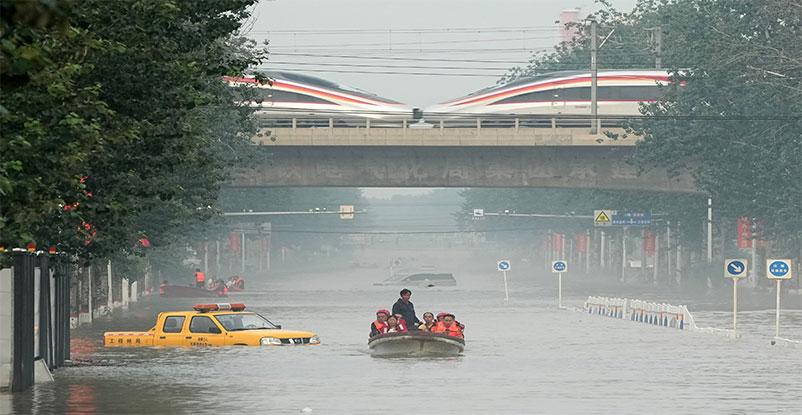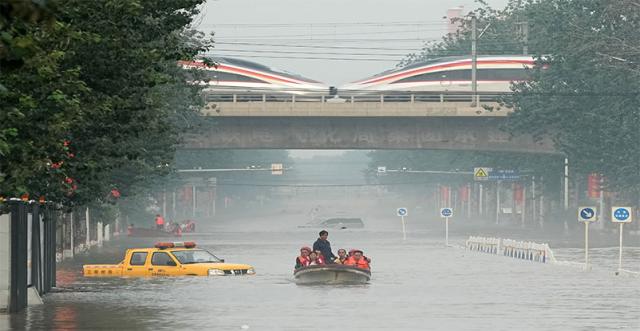In August 2016, Jiao Meiyan, then deputy director of the China Meteorological Administration, told NewsChina that an integrated meteorological early-warning system, using satellites, radar and widespread automatic stations across the country, had been created to provide accurate and timely forecasting. Ahead of the typhoon-induced rainfall, authorities issued alerts for rain and floods.
In early August, Zhang Hengde, deputy director of the National Meteorological Center, told media that such heavy and sustained rainfall in Beijing, Tianjin, Hebei and other regions was extremely rare in China’s history. Beijing Meteorological Bureau said that the maximum rainfall reached 744.8 millimeters in the capital region between July 29 and August 2, the most since records began in 1883.
Settlements in the Haihe River Basin, the largest river system in northern China, which drains areas to the west and south of Beijing and enters the Bohai Sea near Tianjin, were subject to devastating flooding. There were destructive flash floods in the mountainous Fangshan and Mentougou districts of west and southwest Beijing, and regions in the flood plains of the Haihe River were inundated, including Zhuozhou, a city of 662,000 people to the southwest of Beijing’s outlying Fangshan District.
In a speech in 2022, Zhang Jianyun, a scholar at the Chinese Academy of Engineering, said that due to its terrain and the climate impact, the North China Plain is experiencing more frequent storms and flooding, and that extreme weather events will increase.
On the afternoon of August 1, over 100 villagers were trapped by floodwaters in Sanbuqiao Village, part of Zhuozhou. Resident Zhang Liang told NewsChina the flood arrived suddenly at 11pm on July 31. Village leaders had told them to move immediately to a school at a higher elevation. But after sending seniors and children to the evacuation center, Zhang, like most villagers, waited at home. “Most of us preferred to stay home to safeguard livestock and property,” Zhang said. But as the water levels rose so quickly, he had no time to run. Grabbing a few packs of instant noodles, he climbed onto his roof. With no drinking water, he waited for 30 hours before volunteer rescuers reached him.
Despite accurate weather forecasts of heavy rainstorms and early warning of major meteorological disasters on July 29, the intensity and the damage went far beyond people’s expectations. According to Hebei Provincial Flood Control and Drought Relief Office, the accumulated water volume was 27.5 billion cubic meters, over twice the total storage capacity of large and medium-sized reservoirs in the province. Some 1.22 million people were displaced, and among them were 857,200 people relocated from flood diversion and storage areas.
Zhuozhou, located where the Taihang Mountains and Yanshan Mountains meet, is also where several rivers converge. Jia Shaofeng, a researcher at the Institute of Geographical Sciences and Human Resources, Chinese Academy of Sciences, told NewsChina that the terrain exacerbated the severity of the flood in Zhuozhou. Rain and floods usually only occur from late July to early August. In the last 100 years, Zhuozhou has experienced three major floods – in August 1963, August 1996 and July 2012.
“Zhuozhou hadn’t experienced a severe flood for many years, so residents lacked awareness of the risk, opting to take their chances despite the danger,” an anonymous employee from Zhuozhou Water Resources Bureau told NewsChina.
Rescue workers told NewsChina that operations were much more challenging than in previous floods. Jin Shaohui from the China Canoeing Association told the reporter that his group arrived in Zhuozhou with kayaks before dawn on August 1. “Many roads were blocked, so we had to randomly try to make our way in,” Jin said. When the flood waters reached the flatter plain areas, the momentum slowed. But debris, twigs, wires and other obstacles littered the flooded area, blocking passage for their boats or damaging them. They often had to clear a path through the obstacles before they could rescue anyone.
The waters in Beijing, Tianjin and Hebei did not start to recede until August 3, and it will take much longer for river water levels to get back to normal. According to Li Na, deputy director of the Hebei Provincial Water Resources Department, it was estimated that an additional 300 million to 400 million cubic meters of water would pass through Zhuozhou after the flood event. Cheng Xiaotao, an expert in flood control at the China Institute of Water Conservancy, told NewsChina on August 3 that after sustained heavy rainfall, the mountain soils became saturated. This moisture will be gradually released, and the water will continue to converge on the downstream region. “At least the flood peak has passed, so this releases the pressure we saw a few days ago on the downstream region,” Cheng said.

 Old Version
Old Version
